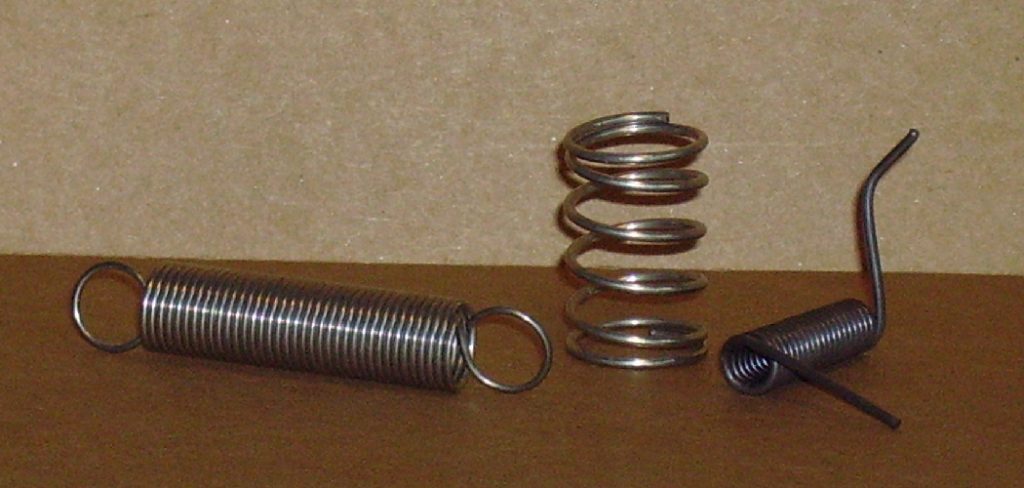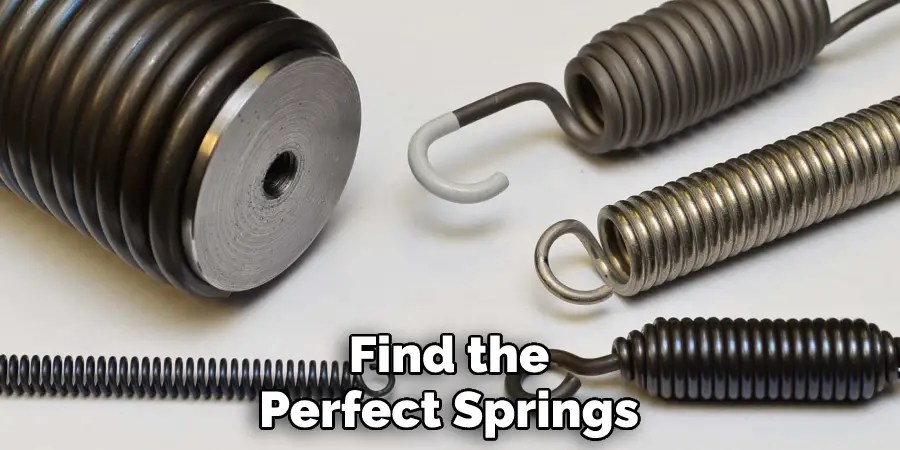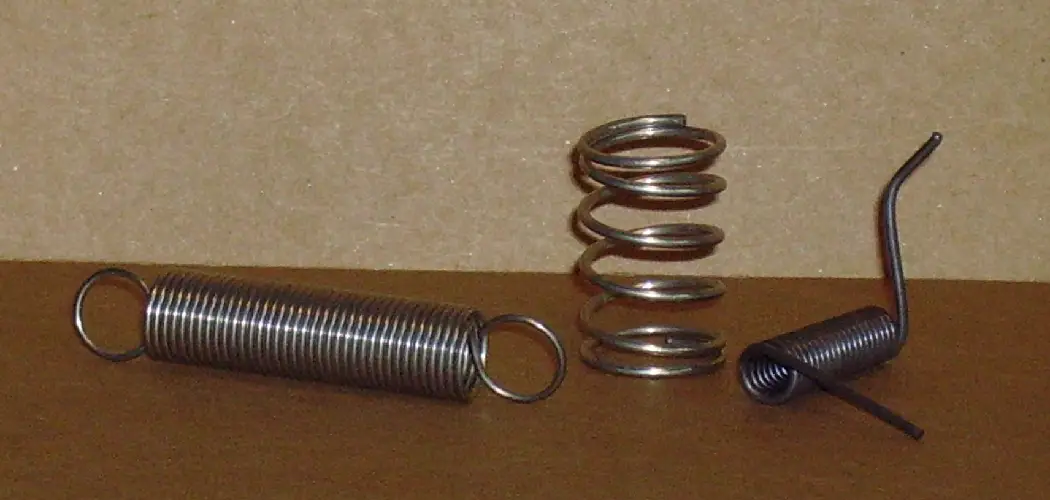Extension springs are an important part of many machines and devices. They are loaded with potential energy, and can be used to store or release kinetic energy. In this blog post, we will teach you how to measure extension springs so that you can select the right one for your project.

What Is Extension Springs?
An extension spring is a type of coiled spring that is designed to extend or stretch under load. It is made of an initial length of coils that are connected at both ends to hooks, eyes, or other attachment devices. As the spring is stretched, the coils wind up and store potential energy.
When the load is removed, the springs recoil back to their original shape and position. Extension springs are used in various applications, such as trampolines, garage door openers, and automotive suspension systems.
Why Should You Measure Extension Springs?
If you’re thinking of investing in extension springs, it’s important to measure them first. Doing so can ensure that the springs will fit your door or window and provide the level of support you need. Measuring extension springs can seem daunting, but it’s actually quite simple. Just follow these steps:
- Using a tape measure, determine the spring’s Overall Length (OAL). This is the length from end to end, including any hooks or eyes.
- Next, measure the Inside Diameter (ID). This is the diameter of the coil itself, not counting the ends.
- Finally, measure the Wire Size (WS). This is the thickness of the wire that makes up the coil.
Once you have these measurements, you can use them to find extension springs that will fit your needs. Then, with some planning, you can be sure to find the perfect springs for your project!

18 Ways to Follow How to Measure Extension Springs
Step 1: Gather Necessary Tools and Materials
Before you begin measuring your extension springs, gather the following tools and materials:
- Tape measure
- Digital calipers (optional)
- Pen and paper or a digital device for recording measurements
- Gloves (to protect your hands from potential hazards)
Step 2: Ensure Safety Precautions
Prior to measuring the extension springs, ensure that the spring is not under tension or load. Disconnect any mechanisms or devices that may apply tension to the spring to prevent accidents or injuries during the measurement process.
Step 3: Measure the Length of the Spring
Using your tape measure or digital calipers, measure the overall length of the extension spring from one end to the other, including the hooks or loops. Record this measurement as the “overall length” of the spring.
Step 4: Measure the Length of the Coil
Next, measure the length of the coil portion of the extension spring. To do this, measure the distance from the inside edge of one hook or loop to the inside edge of the opposite hook or loop. Record this measurement as the “coil length” of the spring.
Step 5: Measure the Diameter of the Wire
To measure the diameter of the wire used in the extension spring, use your digital calipers to measure the thickness of the wire at several points along the spring. Record the average diameter of the wire.
Step 6: Measure the Diameter of the Coil
Measure the diameter of the coil by placing the tape measure or digital calipers across the center of the spring, from one outer edge of the coil to the opposite outer edge. Record this measurement as the “coil diameter” of the spring.
Step 7: Count the Number of Coils
Carefully count the total number of coils in the extension spring. This includes both active and inactive coils. The inactive coils are the coils that are not under tension when the spring is at rest, and they are typically located near the hooks or loops. Record the total number of coils.
Step 8: Identify the Type of Hooks or Loops
Examine the ends of the extension spring to determine the type of hooks or loops that are present. Common types of hooks and loops include:
- Straight hooks: These hooks extend straight out from the end of the spring.
- Cross-over hooks: These hooks cross over each other, forming an “X” shape.
- Double loops: These loops consist of two circles that are connected at the end of the spring.
- No hooks or loops: In some cases, extension springs may not have any hooks or loops.
Record the type of hooks or loops present on your extension spring.
Step 9: Measure the Length of the Hooks or Loops
If your extension spring has hooks or loops, measure the length of each hook or loop from the end of the coil to the end of the hook or loop. Record the length of the hooks or loops.
Step 10: Determine the Maximum Stretch Length
To calculate the maximum stretch length of your extension spring, use the following formula:
Maximum stretch length = (coil length + length of hooks or loops) x desired stretch factor
The desired stretch factor is typically provided by the manufacturer or based on the intended application of the spring. A common stretch factor for general-purpose extension springs is 1.5 to 2 times the coil length.
Step 11: Record All Measurements and Specifications
Compile all of the measurements and specifications you have gathered, including:
- Overall length
- Coil length
- Wire diameter
- Coil diameter
- Number of coils
- Type of hooks or loops
- Length of hooks or loops
- Maximum stretch length
Having a complete and accurate record of these measurements and specifications will be useful when ordering replacement springs or designing custom springs for a specific application.
Step 12: Check Your Measurements
Double-check all of your measurements to ensure accuracy. Incorrect measurements can lead to ordering or manufacturing springs with improper specifications, which may not perform as intended or may even cause damage to equipment or pose safety risks.
Step 13: Compare Measurements to Manufacturer Specifications
If you are measuring an existing extension spring for replacement purposes, compare your measurements to the specifications provided by the original manufacturer, if available. This can help you confirm that you have measured the spring correctly and ensure that you order the correct replacement spring.
Step 14: Understand the Importance of Tolerances
Keep in mind that extension springs are typically manufactured with tolerances. Tolerances are the allowable variations in dimensions and are specified by the manufacturer. When ordering replacement springs or designing custom springs, be aware of these tolerances and consider them in your calculations and measurements.
Step 15: Consult with a Spring Specialist
If you have any questions or concerns about measuring your extension springs, or if you need assistance in selecting the appropriate replacement springs, consult with a spring specialist or manufacturer. They can provide expert guidance and ensure that you obtain the correct springs for your needs.
Step 16: Store the Measured Extension Spring Properly
Once you have completed the measurement process, store the extension spring in a safe and secure location. Avoid exposing the spring to moisture, extreme temperatures, or corrosive substances, as these can cause the spring to deteriorate or lose its tension over time.
Step 17: Order Replacement Springs or Design Custom Springs
With your accurate measurements and specifications in hand, you can now order replacement extension springs or design custom springs for your specific application. Provide the manufacturer with your measurements and specifications, and they will produce springs that meet your requirements.
Step 18: Test the Performance of the New Springs
Once you have received your replacement or custom extension springs, test their performance by installing them in their intended application. Ensure that the springs perform as expected and meet your requirements in terms of load capacity, stretch length, and durability.
By following these steps, you can accurately measure extension springs and ensure that you obtain the correct springs for your needs. Proper measurements and specifications are crucial for the optimal performance and safety of your extension spring applications.
What Are Some Things You Should Know Before Measuring Extension Springs?
Measuring garage door extension springs can be tricky, but with a little know-how, it can be easily mastered. Here are a few things to keep in mind when measuring extension springs:
- Firstly, always use a tape measure or caliper when taking measurements. This will ensure accuracy and prevent errors.
- Secondly, take note of the spring’s free length. This measurement is taken from end to end when the spring is not under any tension or load.
- Next, determine the spring’s wire diameter. This can be done by measuring the thickness of the wire at the widest point.
- Finally, calculate the spring’s inside diameter. This is the measurement taken from one side of the coil to the other, excluding the wire thickness.
With these pointers in mind, measuring extension springs will be a breeze! Keep reading for more information about how to measure extension springs.
Determining How Much Force a Spring Can Exert
Springs are one of the essential components in many machines and devices. They are used to store energy and release it at a later time. By understanding how much force spring can exert, engineers can design more efficient and effective machines. Springs are usually made from metal, such as steel or iron. The thickness of the wire and the number of coils will affect the amount of force that the spring can exert.
To measure the force exerted by a spring, a device called a spring scale can be used. This device measures the tension in the spring, which is directly related to the force exerted by the spring. As a result, engineers can design more reliable and efficient machines by understanding how springs work and measuring their force.
Conclusion
Extension springs are measured by their inner diameter (ID), outer diameter (OD), wire size, and length. The ID is the spring measurement from the inside edge to the inside edge. The OD is the spring measurement from the outside edge to the outside edge. The wire size is how thick the wire is that makes up the spring. Thanks for reading our post about how to measure extension springs.

